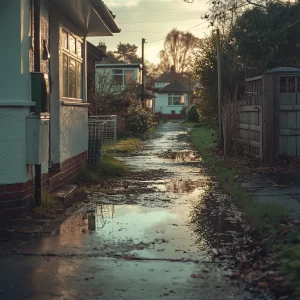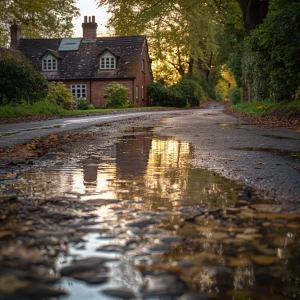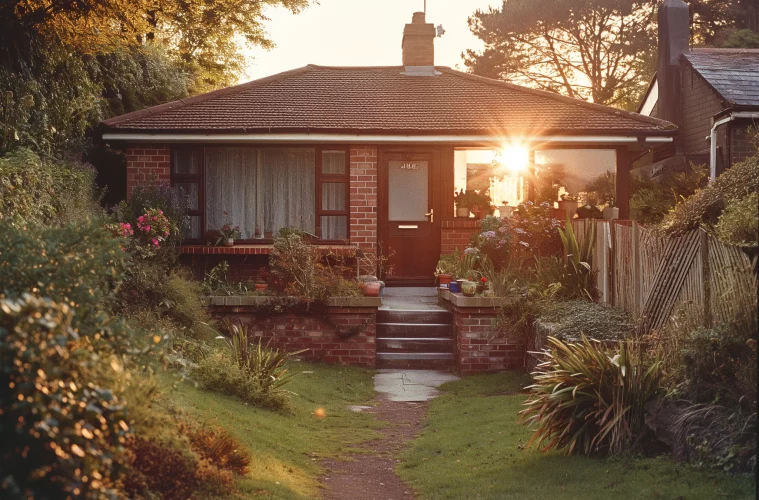In the quest to maintain a sturdy and inviting home, addressing the issue of poor drainage emerges as a pivotal concern for property owners. Ignoring the warning signs of inadequate drainage can lead to many issues, from superficial annoyances to profound structural damages.
Herein, we delve into the crucial indicators that highlight the necessity for immediate intervention and the strategies to mitigate potential damages, ensuring the longevity and safety of your property.
1. Visible and Subtle Drainage Indicators
The first sign of poor drainage is often the most visible: water accumulation. Puddles that linger long after a rainstorm, garden pools that seem to become permanent fixtures, and persistently soggy soil are telltale indicators. When landscapes fail to absorb rainwater efficiently, it is not merely an inconvenience but a symptom of underlying drainage inadequacies.
These conditions, if left unchecked, can escalate, affecting the health of your garden’s vegetation and the foundation of your house. Regular monitoring of your property after weather events can provide early indications of drainage issues, enabling timely interventions that prevent more severe damage.
2. Gutter and Downspout Issues

Gutters and downspouts are critical in directing water away from your property’s foundation. However, blockages due to debris, improper sizing or pitching, and water pooling near the foundation are common issues that compromise their functionality. Overflowing gutters or downspouts that lead water to pool near the base of your home can result in basement and structural damage over time.
Ensuring that gutters are clear of obstructions and that downspouts extend far enough to divert water effectively is essential in safeguarding the integrity of your property. It’s advisable to inspect these components regularly and after significant weather events to ensure they are in optimal condition.
3. Water Intrusion and Damage
Water stains in the basement can offer clues about the type of drainage problem at hand, distinguishing between issues arising from surface runoff and a high water table. Signs of water ingress through the foundation are alarming, indicating that the barrier intended to protect your home from moisture is compromised.
This condition requires immediate attention to identify the source of the water intrusion and implement corrective measures before the problem escalates, potentially leading to more extensive and costly repairs.
4. Structural Integrity Concerns
Distinguishing between harmless and serious foundation cracks is vital in assessing the structural integrity of your property. Cracks resulting from water pressure indicate significant drainage issues that, if not addressed, can lead to burst pipes—severe and visible evidence of structural problems. Regular inspections can help identify these signs early, allowing for the implementation of solutions before the damage becomes irreversible.
“A blocked drainage system can significantly undermine the structural integrity of your property. Water buildup due to clogs or inadequate drainage not only damages foundations but also leads to severe moisture-related issues within the home. Timely intervention and maintenance of your drainage system are paramount to preventing these potentially costly and hazardous outcomes. Remember, what seems like a minor blockage today can escalate into a major repair job tomorrow if left unattended.” – Mark Cordner, 24/7 Drainage UK.
5. Surface and Wall Deterioration
The deterioration of surfaces and walls, evidenced by efflorescence, spalling from water damage, and flaking, signifies moisture problems that extend beyond aesthetic issues. These symptoms of water damage not only detract from the appearance of your home but also indicate potential vulnerabilities in its structural integrity. Addressing these signs promptly can prevent the escalation of damage, maintaining both the aesthetic and structural quality of your property.
6. Unhealthy Indoor Conditions
Indoor conditions such as mildew in the attic from improper venting and the presence of mould indicate high humidity and moisture levels within your home. These conditions can compromise the health of inhabitants, making it imperative to address the root causes of moisture intrusion. Ensuring proper ventilation and addressing any signs of mould or mildew promptly can help maintain a healthy indoor environment.
7. Erosion and Displacement Signs
Signs of erosion and displacement, such as migrating mulch, highlight the inadequacies of soil drainage and the effectiveness of your property’s drainage system. These signs not only affect the appearance of your landscape but can also indicate more significant issues with water management on your property. Implementing solutions to enhance soil drainage and prevent erosion is crucial in maintaining the integrity and appearance of your landscape.
Detection of Blockages and Damage

The early detection of blockages and damage within our drainage systems plays a crucial role in maintaining the health of our homes. Issues such as slow draining, low water pressure, unexplained flooding, unpleasant odours, and strange sounds emanating from the drains indicate underlying problems. These can range from simple clogs to more severe concerns like broken pipes, intrusion by roots or animals, and even the collapse of drainage infrastructure. We must remain vigilant, regularly inspecting and maintaining our drainage systems to identify and address these issues promptly. Ignoring these warning signs can lead to more significant, costly repairs and, in extreme cases, irreversible damage to our properties.
Interventions and Prevention
Interventions in the context of drainage issues range from straightforward, do-it-yourself tasks to complex, professional undertakings. Simple measures, such as keeping gutters free of debris, ensuring downspouts extend away from the foundation, and adopting landscaping practices that promote efficient water runoff, can significantly mitigate the risks associated with poor drainage. For more complex issues, particularly those affecting the foundation or structural integrity of the house, seeking the expertise of structural engineers and professional contractors is advisable. These professionals can assess the severity of the problem, recommend appropriate corrective actions, and implement solutions that ensure the long-term safety and stability of the property.
Furthermore, the significance of preventive measures cannot be overstated. Regular maintenance of gutters and downspouts, proper landscaping, and the installation of drainage solutions like French drains or sump pumps can prevent water accumulation near the foundation, thereby reducing the risk of water damage. Educating ourselves about the signs of drainage problems and adopting a proactive approach to property maintenance can save us from the hassle and expense of dealing with severe damage.
The Importance of a Healthy Living Environment
The implications of poor drainage extend beyond the structural aspects of our homes, affecting the indoor air quality and, by extension, our health. The presence of mould and mildew, often a consequence of excessive moisture and inadequate ventilation, poses significant health risks, particularly to those with respiratory issues or compromised immune systems. We can create healthier, more comfortable living spaces by addressing the root causes of moisture intrusion and ensuring our homes are well-ventilated.
Additionally, the impact of poor drainage on our gardens and outdoor spaces cannot be overlooked. Waterlogged soil can suffocate plant roots, leading to the deterioration of landscaping and, in severe cases, erosion. By implementing effective drainage solutions, we not only protect the structural integrity of our homes but also preserve the beauty and health of our outdoor environments.
Final Thoughts
Maintaining proper drainage is a fundamental aspect of homeownership that requires vigilance, proactive intervention, and a commitment to regular maintenance. By understanding the alarming signs of poor drainage and taking immediate action, we can protect our homes from potential damage, ensure a healthy living environment, and maintain the aesthetic appeal of our properties.
Our homeowners are responsible for educating ourselves on these matters, embracing preventive practices, and seeking professional advice when necessary. Through these efforts, we safeguard our most valuable assets and ensure the well-being of our families for years to come.




